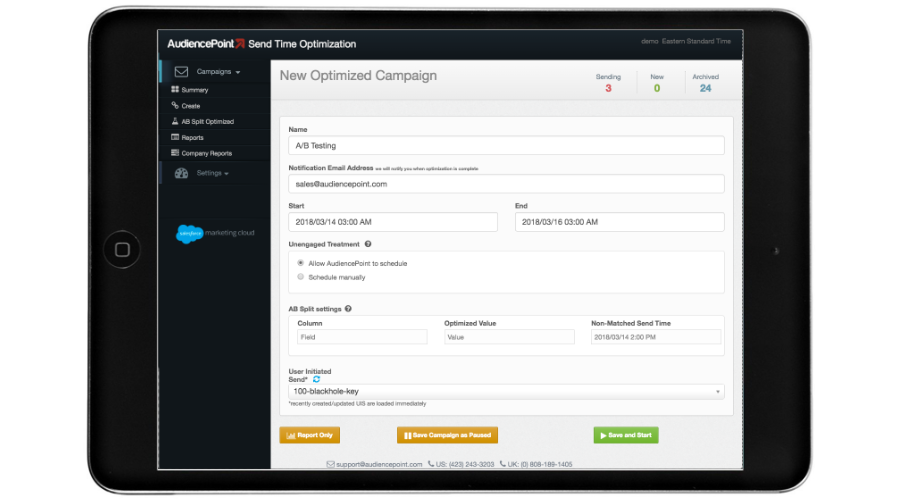AudiencePoint is thrilled to announce our new integration with Klaviyo! AudiencePoint is looking for partners to pilot our...
What Is the Inbox Rate?
In the realm of email marketing, understanding the dynamics of the inbox rate of emails is vital for digital marketing professionals aiming to maximize their email campaigns’ success. The inbox rate refers to the percentage of sent emails that successfully land in the recipient’s primary inbox rather than being diverted to spam or junk folders. This metric, along with Inbox Placement, is a crucial indicator of your email deliverability rate, representing your ability to reach the intended audience effectively.
Importance of Inbox Rate in Email Marketing
Achieving a high inbox rate is significant for several reasons. Firstly, it ensures high engagement levels, as emails in the primary inbox are more likely to be seen and opened. A robust inbox rate also strengthens your sender reputation, paving the way for future emails to be delivered successfully. Furthermore, maintaining a solid inbox rate reduces the chances of your emails ending in the spam folder, thus protecting your campaign’s integrity and maximizing your return on investment.
Factors Affecting Inbox Rate
Several factors can influence the inbox rate of emails. Firstly, the nature of your content plays a pivotal role. Engaging, well-crafted emails that provide value are more likely to land in the primary inbox. Secondly, the sender’s reputation is critical. Consistently sending emails from a reliable domain with relevant content enhances your reputation and increases your inbox rate. Deliverability settings also play a role; properly configured DomainKeys Identified Mail (DKIM) and Sender Policy Framework (SPF) can improve your chances. AudiencePoint’s solutions can help optimize these factors, ensuring superior deliverability rates across your campaigns.
What Is the Inbox Placement Rate?
Understanding the Inbox Placement Rate
The inbox placement rate is a critical metric that assesses the success of your email campaigns. It represents the percentage of emails that successfully reach the recipients’ inboxes rather than being redirected to spam folders or discarded by email providers. Unlike merely tracking the delivery rate, which only signifies that the email was accepted by the server, the inbox placement rate confirms that your message has reached its intended destination in the recipient’s inbox.
Difference Between Inbox Rate and Placement Rate
While often used interchangeably, the inbox rate and inbox placement rate have distinct definitions. The inbox rate may include emails delivered into various folders, including spam or promotional tabs, whereas the placement rate exclusively measures delivery to the primary inbox. Understanding this distinction is vital for evaluating your email marketing strategy.
Tools to Measure Inbox Placement Rate
Employing robust inbox placement tools is paramount in pinpointing where your emails actually land. Tools such as AudiencePoint’s email insight software offer inbox placement tests to ascertain if your emails are reaching the inbox. These tools provide invaluable insights, allowing you to refine your email strategies for optimal results.
Significance of Inbox Placement in Campaign Success
The importance of ensuring high inbox placement rates cannot be overstated in achieving campaign success. Emails that consistently land in the primary inbox demonstrate a higher probability of being opened and engaged, contributing to better email deliverability score. To elevate your campaigns, monitor your placement rates regularly to ensure you are meeting or exceeding industry standards.
What Is The Normal Number Of Emails In An Inbox?
The normal amount of emails in inboxes can vary significantly based on user behavior, industry standards, and personal organization habits. On average, professionals may receive anywhere from 50 to over 300 emails daily, depending on their role and industry. This influx of emails can significantly impact both the email deliverability benchmark and the open-rate email marketing strategies.
Average Amount of Daily Emails Received
Understanding the average number of emails in your inbox is essential for marketers striving for high deliverability rates. According to recent statistics, the average office worker receives about 121 emails every day. This number underscores the importance of distinguishing your emails through effective targeting and personalization strategies.
Impact on Deliverability and Open Rates
High volumes of emails can negatively influence deliverability and open rates. As users become overwhelmed with high inbox counts, emails might be more likely to be ignored, redirected to spam, or deleted without being opened. This calls for strategic planning in email timing, relevance, and content to maintain and improve the email deliverability benchmark.
Strategies to Manage Inbox Overload
One of the most effective ways to manage inbox overload is to implement a disciplined approach toward organization and prioritization. Encourage recipients to use techniques such as email filtering, prioritization, and time-blocking to manage their email load effectively. Marketers can help by ensuring emails are clear, relevant, and concise, making them easier to process and more likely to be opened and engaged with.
What Is a Good Click Rate for Email?
Email click rate is a critical metric in the world of email marketing. It is defined as the percentage of email recipients who click on one or more links contained in a given email. This metric goes beyond simply opening an email; it measures active engagement and is a strong indicator of how well your content resonates with your audience.
Industry Benchmarks for Click Rates
Understanding industry benchmarks can set realistic expectations for your email campaigns. Generally, a good click rate for email ranges between 2-5%. However, this can vary significantly depending on the industry and the type of campaign. For B2B emails, the average click-through rate is slightly higher at around 3.2%. Aiming for a click-through rate in this range or higher indicates effective communication and compelling call-to-actions that drive engagement.
Tips for Improving Email Click Rates
Improving your click rate starts with understanding your audience and what drives them to engage. Here are some actionable tips from the email deliverability guide:
- Craft Engaging Content: Make sure your email content offers value to the recipient. Whether it’s educational content, special offers, or engaging stories, compelling content drives clicks.
- A/B Testing: Regularly test different elements of your emails, such as subject lines, CTAs, and content layout, to find out what resonates best with your audience.
- Segmentation: Tailor your messages to specific segments of your audience. Personalized and relevant emails are more likely to result in higher engagement.
- Clear Call-to-Action (CTA): Ensure that your CTA is visible, enticing, and easy to find. A strong, clear CTA can significantly elevate the click rate.
To achieve exceptional results in email marketing, it’s essential to have a robust strategy focusing on meticulous content preparation, strategic segmentation, and precise targeting.
Supercharge your email marketing results with AudiencePoint’s comprehensive insights into your subscribers’ engagement. Uncover hidden patterns and optimize your click rates using our precise data analysis tools. Boost your email campaign’s effectiveness with AudiencePoint’s advanced solutions that drive meaningful engagement and revenue. Contact AudiencePoint today!





